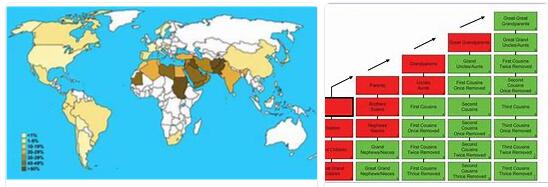The Latin word consanguinĭtas came to our language as consanguinity. It is a word that is the result of the sum of several clearly delimited elements such as these:
-The prefix “with”, which means “together”.
-The noun “sanguis”, which is synonymous with “blood”.
-The suffix “-dad”, which is used to indicate “quality”.
This is the name of the relationship that two or more people have with a close ancestor in common.
Consanguinity, therefore, is a blood bond between individuals. These subjects are said to share blood because they have a common ancestor. There are other relationships, on the other hand, that do not have consanguinity, but are established through the law. If a married couple adopts a child, a parental relationship is established, but without consanguinity: the child and his adoptive parents have no common ancestors.
Therefore, it is possible to distinguish between kinship by consanguinity and kinship by affinity. These notions are important in the legal field since they determine how the rights related to the family are established.
The degrees of consanguinity are especially important within the workplace when it comes to being able to enjoy permits for the people with whom they are held. That is, to be able to make use of permits for birth, illness, death…
In this case, several types of degrees of consanguinity are established:
-First degree, in which the father, mother, son or daughter are found.
-Second grade, where the grandfather, grandmother, brother, sister, grandson or granddaughter are framed.
-Third degree. In this one are the uncle, the aunt, the great-grandfather, the great-grandmother, the great-grandson or the great-granddaughter as well as the nephew and the niece.
-Fourth grade, where the great-uncles and cousins are.
When applying for certain permits, the degrees of affinity must also be taken into account. In this case, two fundamentally stand out:
-The first degree, where the father-in-law and mother-in-law are, as well as the daughter-in-law and son-in-law.
-The second degree, where the brother-in-law and sister-in-law are framed.
Although the laws vary according to the country, it is usual for the blood relationship to be equated with the relationship established through adoption. An adopted child, in this way, has the same rights as a natural child. Thus, the inheritance is distributed equally among all the children, for example, regardless of the existence or not of consanguinity.
It should be noted that, according to the generations that are interposed in the genealogical tree of a person, different degrees of consanguinity can be recognized. The bond between a father and a son, to cite one case, is of the first degree. Consanguinity can occur by direct line (individuals who descend from each other) or by collateral line (these relatives do not descend from each other, although they share the same trunk, like siblings).
It is important to establish that for centuries there have been unions of couples that had the peculiarity that their members presented consanguinity. A situation that can bring with it that the children they have mental retardation, congenital malformations or very serious hereditary diseases.
